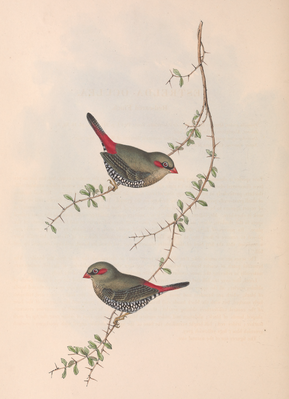Red-eared amadine
| Red-eared amadine | ||||||||||||
|---|---|---|---|---|---|---|---|---|---|---|---|---|

Red-eared amadine |
||||||||||||
| Systematics | ||||||||||||
|
||||||||||||
| Scientific name | ||||||||||||
| Stagonopleura oculata | ||||||||||||
| ( Quoy & Gaimard , 1830) |
The red-eared amadine ( Stagonopleura oculata ) is an Australian species from the finch family . It has one of the smallest ranges of the Australian finches. No subspecies are distinguished for this species. Together with the fire tailed amadine , it forms a super species .
description
The red-eared amadine reaches a body length of twelve centimeters and weighs between 7.9 and 14 grams. There is not a very pronounced sexual dimorphism . The red-eared amadine is very similar to the fire- tailed amadine, although the red ear covers that give this species its name are missing.
The short, strong and conical beak is red and slightly lightened towards the base of the beak. The forehead, reins and a small area around the eye are black. The eye is red and surrounded by a pale bluish rim of the eyelid. The cheeks are warm brown, the ear covers form a bright red field, which is darker red in the male during the breeding season. In the female, the ear covers are then a little paler, more a red playing into orange. The top of the head, neck, back, shoulder feathers and wing covers are light to medium olive brown and have fine black transverse bands. The chin, throat and front chest are light yellowish-brown with a fine, blackish transverse wave. The rest of the underside of the body is black and shows rough white spots, some of which merge into one another, some of which overlap. They form rows on the under tail coverts. The bright red of the rump extends to the bases of the central control feathers , the rest of the tail is brownish and darkly banded. The flight feathers are gray-brown and have dark, quite far apart stripes. The feet are mostly dark brown, more rarely flesh-colored brown.
The young birds are dull brown and a little lighter on the underside of the body. Your transverse ligament is only hinted at. The beak is still black and the red ear mark is missing.
voice
The call repertoire of the red-eared amadine is very large compared to the Australian finch species that occur in the arid regions. The call, a clear, plaintive-whistling like-ie or u-like , is similar to that of the fire-tailed amadine, but is almost always two-syllable. The close contact call is a soft quirk or quork . The singing consists of numerous individual notes, which are performed in ascending rows and end with a strong or panting sound. The courtship song is based on the call and sounds something like U-wie-ju-ju-ju-ju-ju-ju .
Distribution and way of life
The distribution area of the red-eared amadine is limited to the Eucalyptus marginata forests in southwestern Western Australia. It occurs only in the hinterland of Perth and the Darling Range . It is much more specialized than most of the other fine Australian finches. Their preferred habitat are clearings in the eucalyptus forest, which have a dense shrub-like undergrowth. It is particularly common in ravines and is largely absent in the highlands.
The red-eared amadine is a resident bird that normally does not leave its breeding area. Only the young birds roam a little further in the autumn of their first year of life.
The diet consists of grass seeds and the seeds of the casuarina . The birds also eat small insects and snails.
The breeding season falls in the southern spring and takes place in the months of August to November. The nest is well camouflaged in the end branches of tall eucalyptus trees and is between eight and thirty meters above the ground. The nest, including the entrance tube, can be up to 40 centimeters long and consists of up to 2,000 individual parts. The clutch comprises four to six white eggs. Both parent birds breed, with the two partners separating about 1.5 hours apart. Up to their eighth day of life, the young birds are huddled by their parent birds .
attitude
Red-eared amadines hardly play a role in European ornamental bird keeping and are only kept very rarely in Australia. The first bird of this kind was kept in Germany in 1873. Since then, however, they have only been on the market very rarely and irregularly.
supporting documents
literature
- Jürgen Nicolai (Ed.), Joachim Steinbacher (Ed.), Renate van den Elzen, Gerhard Hofmann: Prachtfinken - Australia, Oceania, Southeast Asia. Eugen Ulmer Verlag, Stuttgart 2001, ISBN 3-8001-3249-4 .
- Peter Clement , Alan Harris, John Davis: Finches and Sparrows. An Identification Guide. Christopher Helm, London 1993, ISBN 0-7136-8017-2 .
Single receipts
- ↑ Nicolai et al., P. 29.
- ↑ Nicolai et al., P. 29.
- ↑ Nicolai et al., P. 31.
- ↑ Nicolai et al., P. 31.
- ↑ Nicolai et al., P. 31.
- ↑ Nicolai et al., P. 32.
Web links
- Stagonopleura oculata in the endangered Red List species the IUCN 2009. Posted by: BirdLife International, 2009. Retrieved on July 4 of 2010.
- Videos, photos and sound recordings of Stagonopleura oculata in the Internet Bird Collection